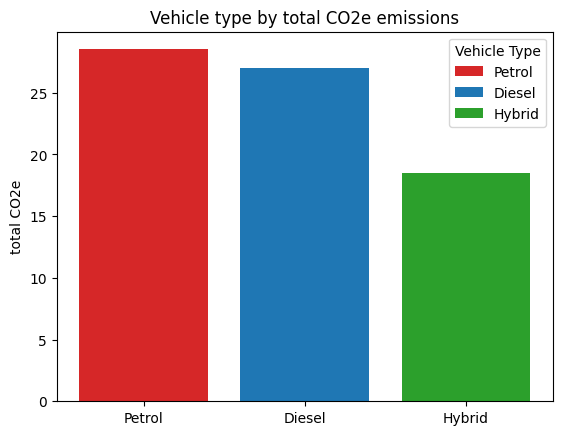Carbon-aware fleet vehicle selection for crews¶
Table of contents
Overview
Setup
Get Token
Utility Functions
Function to call API
Input format for API
Accepted input values
Use Case Implementation
Fastest route
Shortest route
Comparison Between Routes
Related Links
Overview¶
APIs that are used in this sample: IBM Envizi - Emissions API, Mobile Emissions API
You can calculate the emissions produced based on the type of vehicle and fuel type for a given route. This approach helps you to choose the most sustainable option for task completion, while balancing operational cost and environmental responsibility.
The U.S. Environmental Protection Agency calculates that the transportation sector generates the largest share, approximately 29%, of Greenhouse Gas Emissions. As a result, carbon-responsible enterprises are focusing on reducing transportation-related emissions where possible. A carbon-aware approach to vehicle selection for crews has the potential to reduce the carbon footprint of an organization, while still fulfilling work orders.
Business value
Reduction of carbon footprint
Sustainable work order fulfillment
Use Case
Consider a scenario where a utility company needs to dispatch a crew for maintenance. We can evaluate a vehicle’s emissions based on the vehicle type and fuel type.
For more information on the inputs and output data points for the Emissions API- Mobile endpoint, see the Emissions API Developer Guide or take a look at the Data Catalog.

Setup¶
Ensure that Python 3+ is installed on your system.
Note: To run this notebook, you must first add your credentials to '../../../../auth/secrets.ini' in the following format:
[EAPI]
api.api_key = <Your Emissions API Key>
api.tenant_id = <Your Emissions API Tenant Id>
api.org_id = <Your Emissions API Org Id>
[ ]:
# Install the prerequisite Python packages
%pip install pandas configparser IPython matplotlib
[20]:
import pandas as pd
import configparser
import requests
import json
from IPython.display import display as display_summary
import matplotlib.pyplot as plt
Authorization Token¶
Run the following code snippet to generate a Bearer Token by using your api_key configured in secrets.ini.
[21]:
config = configparser.RawConfigParser()
config.read(['../../../../auth/secrets.ini','../../../../auth/config.ini'])
EAPI_API_KEY = config.get('EAPI', 'api.api_key')
EAPI_TENANT_ID = config.get('EAPI', 'api.tenant_id')
EAPI_CLIENT_ID = 'ghgemissions-' + EAPI_TENANT_ID
EAPI_ORG_ID = config.get('EAPI', 'api.org_id')
EAPI_AUTH_CLIENT_ID = 'saascore-' + EAPI_TENANT_ID
EAPI_AUTH_ENDPOINT = config.get('EAPI', 'api.auth_endpoint')
EAPI_BASE_URL = config.get('EAPI', 'api.base_url')
EAPI_ENDPOINT = f"{EAPI_BASE_URL}/mobile"
auth_request_headers: dict = {}
auth_request_headers["X-IBM-Client-Id"] = EAPI_AUTH_CLIENT_ID
auth_request_headers["X-API-Key"] = EAPI_API_KEY
verify = True
auth_url = f"{EAPI_AUTH_ENDPOINT}?orgId={EAPI_ORG_ID}"
response = requests.get(url = auth_url,
headers = auth_request_headers,
verify = verify
)
if response.status_code == 200:
jwt_token = response.text
print("Authentication Success")
else:
print("Authentication Failed")
print(response.text)
Authentication Success
Use Case Implementation¶
Petrol¶
Now, using the Mobile Emissions API, calculate the emissions for a petrol vehicle.
[3]:
petrol_payload = {
"activity": {
"type": "Passenger Vehicles - Medium Car - Petrol",
"value": 100,
"unit": "mi"
},
"location": {
"country": "USA",
"stateProvince": "New York"
},
"time": {
"date": "2025-01-01"
}
}
[4]:
# Create the query headers
request_headers: dict = {}
request_headers["Content-Type"] = "application/json"
request_headers["x-ibm-client-id"] = EAPI_CLIENT_ID
request_headers["Authorization"] = "Bearer " + jwt_token
[5]:
# Submit the request
petrol_response = requests.post(EAPI_ENDPOINT,
headers = request_headers,
data = json.dumps(petrol_payload))
[6]:
if petrol_response.text != "":
# Get the response as json
response_json = petrol_response.json()
# Get json and convert to dataframe
json_str = json.dumps(response_json)
dict = json.loads(json_str)
dataframe = pd.json_normalize(dict)
# display
print("\n\n")
pd.set_option('display.max_colwidth', None)
display( dataframe)
else:
print("Empty Response")
| transactionId | totalCO2e | CO2 | CH4 | N2O | unit | description | |
|---|---|---|---|---|---|---|---|
| 0 | ad4f34c3-75b8-4515-8ec8-ee7bfe62e628 | 28.527232 | 28.417796 | 0.057936 | 0.051499 | kgCO2e | The passenger vehicles - medium car - petrol emissions factor used to calculate this result was obtained from the 2024 Managed - DEFRA factor set |
Diesel¶
Using the Emissions API- Mobile endpoint, calculate the emissions for a diesel vehicle.
[7]:
diesel_payload = {
"activity": {
"type": "Passenger Vehicles - Medium Car - Diesel",
"value": 100,
"unit": "mi"
},
"location": {
"country": "USA",
"stateProvince": "New York"
},
"time": {
"date": "2025-01-01"
}
}
[8]:
# Create the query headers
request_headers: dict = {}
request_headers["Content-Type"] = "application/json"
request_headers["x-ibm-client-id"] = EAPI_CLIENT_ID
request_headers["Authorization"] = "Bearer " + jwt_token
[9]:
# Submit the request
diesel_response = requests.post(EAPI_ENDPOINT,
headers = request_headers,
data = json.dumps(diesel_payload))
[10]:
if diesel_response.text != "":
# Get the response as json
response_json = diesel_response.json()
# Get json and convert to dataframe
json_str = json.dumps(response_json)
dict = json.loads(json_str)
dataframe = pd.json_normalize(dict)
# display
print("\n\n")
pd.set_option('display.max_colwidth', None)
display( dataframe)
else:
print("Empty Response")
| transactionId | totalCO2e | CO2 | N2O | unit | description | |
|---|---|---|---|---|---|---|
| 0 | d17e04f7-79bf-45b1-a9b2-8d47e6f9ef3c | 27.048245 | 26.779484 | 0.26876 | kgCO2e | The passenger vehicles - medium car - diesel emissions factor used to calculate this result was obtained from the 2024 Managed - DEFRA factor set |
Hybrid¶
Using the Emissions API- Mobile endpoint, calculate the emissions for a hybrid vehicle.
[11]:
hybrid_payload = {
"activity": {
"type": "Passenger Vehicles - Medium Car - Hybrid",
"value": 100,
"unit": "mi"
},
"location": {
"country": "USA",
"stateProvince": "New York"
},
"time": {
"date": "2025-01-01"
}
}
[12]:
# Create the query headers
request_headers: dict = {}
request_headers["Content-Type"] = "application/json"
request_headers["x-ibm-client-id"] = EAPI_CLIENT_ID
request_headers["Authorization"] = "Bearer " + jwt_token
[13]:
# Submit the request
hybrid_response = requests.post(EAPI_ENDPOINT,
headers = request_headers,
data = json.dumps(hybrid_payload))
[14]:
if hybrid_response.text != "":
# Get the response as json
response_json = hybrid_response.json()
# Get json and convert to dataframe
json_str = json.dumps(response_json)
dict = json.loads(json_str)
dataframe = pd.json_normalize(dict)
# display
print("\n\n")
pd.set_option('display.max_colwidth', None)
display( dataframe)
else:
print("Empty Response")
| transactionId | totalCO2e | CO2 | CH4 | N2O | unit | description | |
|---|---|---|---|---|---|---|---|
| 0 | 0cd3e0a6-3fe2-460c-a3e8-3005e8d19a7b | 18.491363 | 18.296632 | 0.027359 | 0.167372 | kgCO2e | The passenger vehicles - medium car - hybrid emissions factor used to calculate this result was obtained from the 2024 Managed - DEFRA factor set |
You can check the accepted values for the individual fields of the request payload. For more information, see Emissions API Developer Guide.
Comparison Between Vehicles¶
[15]:
import matplotlib.pyplot as plt
fig, ax = plt.subplots()
vehicles = ['Petrol', 'Diesel', 'Hybrid']
emissions = [round(petrol_response.json()['totalCO2e'], 3),
round(diesel_response.json()['totalCO2e'], 3),
round(hybrid_response.json()['totalCO2e'], 3)]
bar_labels = ['Petrol', 'Diesel', 'Hybrid']
bar_colors = ['tab:red', 'tab:blue', 'tab:green']
ax.bar(vehicles, emissions, label=bar_labels, color=bar_colors)
ax.set_ylabel('total CO2e')
ax.set_title('Vehicle type by total CO2e emissions')
ax.legend(title='Vehicle Type')
plt.show()
